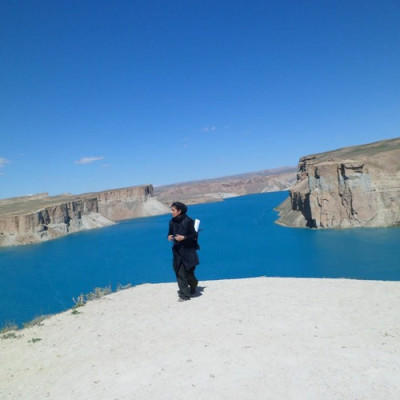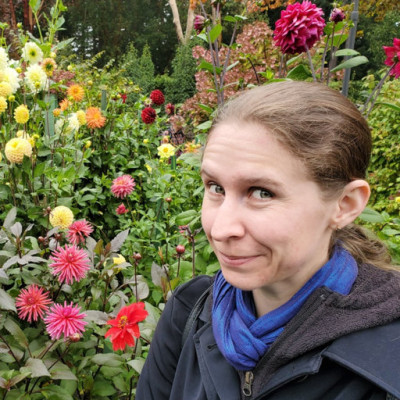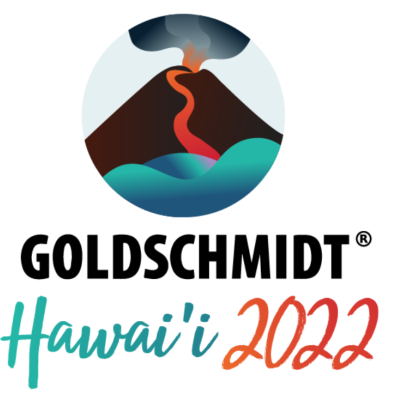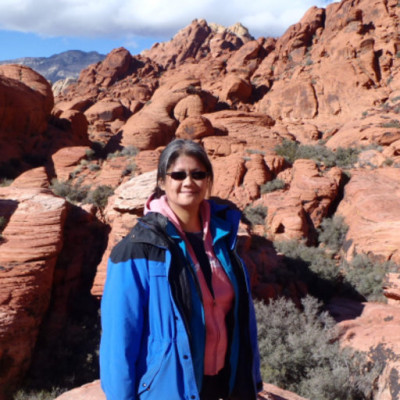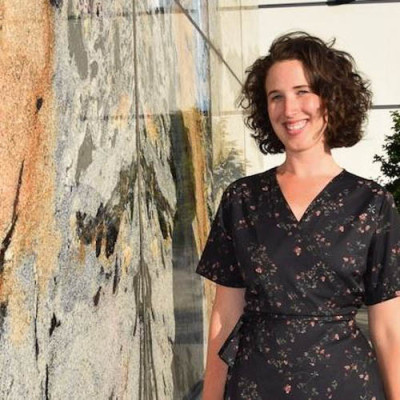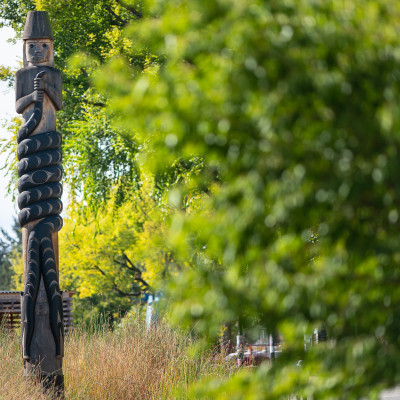News
Stay up-to-date with what's happening in EOAS
Meet Marghaleray Amini - Geochemist
Marghaleray Amini received a Master’s degree from the Max Planck Institute for Chemistry in Mainz, Germany (2003), and a PhD from Geomar Helmholtz Centre for Ocean Research in Kiel, Germany (2007), where she studied the chemical and isotopic compositions of marine hydrothermal systems. During her postdoctoral positions in the Saskatchewan Isotope Laboratory at the University of Saskatchewan, and in Mainz within the DFG-funded Geocycles program, she worked on the application of metal stable isotope systems in biogeochemical cycles. Dr. Amini has worked aboard research cruises and in field sites in remote areas such as the North Pole and the Band-e-Amir lakes in Afghanistan. She joined Kabul University as a Scientific Advisor and lecturer as part of the German Foreign Aid development program. In 2012, she joined PCIGR as a Research Associate, where she oversaw the operation of the nUBC research facility, and is in direct charge of the laser ablation ICP-MS. Her research interests include developing new methodological approaches to trace biogeochemical reaction pathways across interphases.
Meet Rhiana Elizabeth Henry - Mineralogist
Rhiana Elizabeth Henry is a Ph.D. candidate at the University of British Columbia, department of Earth, Ocean, and Atmospheric Sciences, within the Mineralogical Research Group led by Dr. Lee Groat. Her specialty is gemstone mineralogy. Her Ph.D research is on the crystal-chemistry of beryl. She uses single-crystal X-ray diffraction and chemical analyses to study the H2O content within the crystal structure of beryl, related to Na content, chemical differences between beryl varieties, and to create a predictive model of how the beryl structure changes with varied chemistry. This work can be used to help inform geological and gemological studies on beryl, find unique subtypes, and the modeling method can be extended to other minerals in the future. Rhiana completed her M.Sc. in Geologic Sciences at the University of Colorado at Boulder in 2018 studying the crystallography of a Be-Fe-REE mineral gadolinite. She completed her Graduate Gemologist certification in 2018 at the Gemological Institute of America. She completed her two B.A. degrees in Physics and Geological Sciences at the University of Colorado at Boulder in 2013. She has been a teaching assistant for three different physics courses and four different geology courses. She is the mineral name checker for the journal Canadian Mineralogist, ensuring mineral names are properly described before publication. She is passionate about using gemstone mineralogy as a gateway for new students into geological science.
EOAS at Goldschmidt 2022
Goldschmidt is the foremost annual, international conference on geochemistry and related subjects, organised by the European Association of Geochemistry and the Geochemical Society. Researchers from the Department of Earth, Ocean and Atmospheric Sciences (EOAS) at UBC has been attending the Goldschmidt for many years. Here we inventoried the presentations authored by EOAS members at the Goldschmidt 2022.
| Author | Title (click for presentation link) | Session/Theme |
| Anne_Martine Doucet, Frances Ann Jones, Bethany Ladd, Andrew Black, Greg Dipple, K. Ulrich Mayer | Measuring CO2 Exchange over the Hydromagnesite-Magnesite Playas in Atlin, B.C. | 8d - Carbon Capture, Utilization, and Storage (CCUS): developments in assessment, optimization and monitoring; Theme 08: Energy and Resources in Service of Society |
| Brooke Hoppstock-Mattson, Josephine Maton, Dominique Weis, Kate E. Smith, Nadine Mattielli | A Tale of Two Cities: Comparison of metals and Pb isotopes in honey from Vancouver, Canada, and Brussels, Belgium, during the COVID-19 lockdown | 12f - Novel techniques and Applications of Metals & Their Isotopes: From Environment to Human biology; Theme 12: Metals and Nutrient Cycling |
| Catriona M Breasley, Tania Martins, Robert L Linnen, Lee A Groat | Lithium mineralization and remobilization at the Tanco pegmatite, Manitoba | 8h - Raw materials for a low carbon future; Theme 08: Energy and Resources in Service of Society |
| Connor Turvey, Eric Wynands, Greg Dipple | A new method for rapid characterization of carbon sequestration potential using thermogravimetric analysis | 8k - Silicate mineral weathering and carbonate mineralization: applications of CO2-fluid-mineral reactions to surficial and subsurface carbon capture and storage; Theme 08: Energy and Resources in Service of Society |
| Corey J. Wall, James S. Scoates, Nichole Moerhuis, Graham T. Nixon | Construction rates of ultramafic-mafic intrusions in the Earth’s crust from U-Pb zircon geochronology | 5f - From source to surface: Characterizing magma generation and ascent processes from the rock record; Theme 05: Volcanism in the Earth System |
| Dominique Weis (Keynote Speaker) | The Deep Mantle and Ocean Island Basalts: Views from Two Major Mantle EM-I Plumes – Kerguelen and Hawai'i | 5b - Geochemical and isotopic compositions of volcanic magmas and their sources: A tribute to Frederick A. Frey; Theme 05: Volcanism in the Earth System |
| Dylan W. Spence, James S. Scoates, James A. Nott, Dejan Milidragovic, Graham T. Nixon | Olivine in primitive arc magmas from the Polaris Alaskan-type intrusion in the North American Cordillera | 5c - Exploring the physical and chemical evolution of magmas in volcanic plumbing systems; Theme 05: Volcanism in the Earth System |
|
Eric Wynands, Ethan Alban, Greg Dipple |
Carbon Dioxide Injection into Processed Kimberlite at the Metre Scale and Beyond | 8d - Carbon Capture, Utilization, and Storage (CCUS): developments in assessment, optimization and monitoring; Theme 08: Energy and Resources in Service of Society |
| Evelyn Frères, Dominique Weis, Kathy Gordon | Matrix effects in MC-ICP-MS: an isotopic case study for Pb | 6b - Technological and methodological advances in isotope geochemistry; Theme 06: Novel Methods: Nanoscale Techniques to Big Data |
| Frances Ann Jones, Anne_Martine Doucet, Bethany Ladd, K. Ulrich Mayer, Andrew Black, Greg Dipple | Advances in monitoring carbon dioxide exchange between the atmosphere and mine waste derived from ultramafic-hosted mineral deposits; a pilot study at Cassiar, B.C. | 8d - Carbon Capture, Utilization, and Storage (CCUS): developments in assessment, optimization and monitoring; Theme 08: Energy and Resources in Service of Society |
| James A. Nott, James S. Scoates, Dejan Milidragovic, Graham T. Nixon, Dylan W. Spence, | Primitive arc magma conduits from the zircon petrochronology perspective in the Polaris Alaskan-type intrusion, North American Cordillera | 5f - From source to surface: Characterizing magma generation and ascent processes from the rock record; Theme 05: Volcanism in the Earth System |
| James S. Scoates, Dominique Weis | Connecting flood basalts and intrusions in oceanic plateaus from the Kerguelen Archipelago | 5b - Geochemical and isotopic compositions of volcanic magmas and their sources: A tribute to Frederick A. Frey; Theme 05: Volcanism in the Earth System |
| Jasmine Elizabeth Chase, Brooke Hoppstock-Mattson, Dominique Weis | How do you like your fish? Methods development for the analysis of lead isotopes and trace metal concentrations in Pacific Salmon | 12f - Novel techniques and Applications of Metals & Their Isotopes: From Environment to Human biology; Theme 12: Metals and Nutrient Cycling |
| Lauren N. Harrison, Dominique Weis, James S. Scoates, John M. O'Connor, Marcel Regelous, Amy Baco, E. Brendan Roark | Renewed Volcanism at the Hawaiian-Emperor Bend at ~31 Ma | 5b - Geochemical and isotopic compositions of volcanic magmas and their sources: A tribute to Frederick A. Frey; Theme 05: Volcanism in the Earth System |
| Lindsey Abdale, Lee A Groat, Philippe Belley, Jan Cempirek, Corey Wall | Corundum genesis in aluminous leucosomes at the Blue Jay Sapphire occurrence (British Columbia, Canada) as a record of metamorphism and partial melting in the Monashee Complex | 7d - Advances in ore and gem mineral chemistry: Insights into mineral deposit formation and metal cycling in the Earth system; Theme 07: Mineral, Melt, and Fluid Chemistry |
| Jingao Liu, D Graham Pearson, Lawrence Hongliang Wang, Kathy Mather, Bruce Kjarsgaard, Andrew Schaeffer, Gordon Irvine, Maya G Kopylova, John Armstrong | Plume-driven recratonization of deep continental lithospheric mantle - 2022 Shen-Su Sun Award | 3a - Formation and evolution of oceanic and continental lithospheric mantle; Theme 03: Earth's Lithosphere Formation and Evolution from Hadean to Modern |
| Mingliang Xie, Danyang Su, K. Ulrich Mayer, Kerry T.B. MacQuarrie | Reactive transport investigations of the long-term geochemical evolution of a multibarrier system and impacts on radionuclide migration | 13d - Integration of experimental and field data in geochemical reactive transport models and its use for predictive models and long-term performance assessments; Theme 13: Environmental Geochemistry: Contaminants, Geo-engineering, and Human Health |
| Nichole Moerhuis, James S. Scoates, Dominique Weis, R.F. Jon Scoates, Christian Tegner | Zircon diversity in the Skaergaard intrusion and the late-stage evolution of mafic intrusions in sub-volcanic magma plumbing systems | 5c - Exploring the physical and chemical evolution of magmas in volcanic plumbing systems; Theme 05: Volcanism in the Earth System |
| Nicole M.B. Williamson, Dominique Weis, James S. Scoates, Michael O. Garcia | How atypical is Kauaʻi’s Loa-Kea geochemical trend? | 5b - Geochemical and isotopic compositions of volcanic magmas and their sources: A tribute to Frederick A. Frey; Theme 05: Volcanism in the Earth System |
| Sterling Vanderzee, Greg Dipple, Peter Bradshaw | Machine Learning and Mass Balance Methods for the Quantifying Carbon Capture Capacity of Nickel Deposits from Whole-rock Geochemistry: Strengths, Weaknesses, and Best Practices | 8d - Carbon Capture, Utilization, and Storage (CCUS): developments in assessment, optimization and monitoring; Theme 08: Energy and Resources in Service of Society |
| Xueya Lu, Greg Dipple | Characterizing cation release for assessing carbon capture and storage reactivity of Ultramafic Mine Tailings | 8k - Silicate mineral weathering and carbonate mineralization: applications of CO2-fluid-mineral reactions to surficial and subsurface carbon capture and storage; Theme 08: Energy and Resources in Service of Society |
If you attended the Goldschmidt 2022 but we missed you in the inventory, please let us know (For_EOAS_Web@eoas.ubc.ca).
Meet Dr. Alice Chang - PCIGR Project Manager
Alice is an EOAS alumna, having obtained a BSc degree (Hon., First Class) when the department was called Geological Sciences, and a MSc degree when the department became Earth and Ocean Sciences. Her thesis projects involved the sedimentology and micropaleontology of diatomaceous marine sediments of Miocene age from southern California. She subsequently pursued a PhD at Carleton University (Ottawa), researching late Holocene diatomaceous marine sediments from Vancouver Island. This was followed by a postdoctoral fellowship at the University of Victoria, where she analyzed the geochemistry of late Quaternary marine sediments from along the western North American margin. Alice then managed analytical laboratories in the Faculty of Forestry at UBC before returning to EOAS, where she is currently a project manager at PCIGR.
COVID Impact on Field Work - Frances Jones
The pandemic has caused significant impacts on fieldwork, which is essential to the research of many graduate students. Watch our interview with Frances Jones, MSc Student in Geological Sciences to learn how her original fieldwork plan was affected by COVID and how she overcame the challenges.
How do I get started? Creating safer learning environments for Indigenous students in STEM at UBC
This resource (click here), developed by UBC SKYLIGHT: The Science Centre for Learning and Teaching, responds to commonly asked questions about how STEM faculty can ‘get started’ with ‘Indigenizing our curriculum’ (UBC ISP Goal #4) and creating safer classroom environments for Indigenous students. The responses to the questions are informed by conversations with Indigenous students, faculty, and staff in UBC Science, the CTLT Indigenous Initiatives team, and our colleagues in Skylight, and also include links to relevant UBC, BC, and Canadian resources and professional development opportunities.
This document and other EDI resources curated by the EOAS EDI committee can also be found here: https://www.eoas.ubc.ca/edi-and-safety/edi/resources
